AUDI A3 CABRIOLET 2016 Owners Manual
Manufacturer: AUDI, Model Year: 2016, Model line: A3 CABRIOLET, Model: AUDI A3 CABRIOLET 2016Pages: 272, PDF Size: 67.88 MB
Page 211 of 272
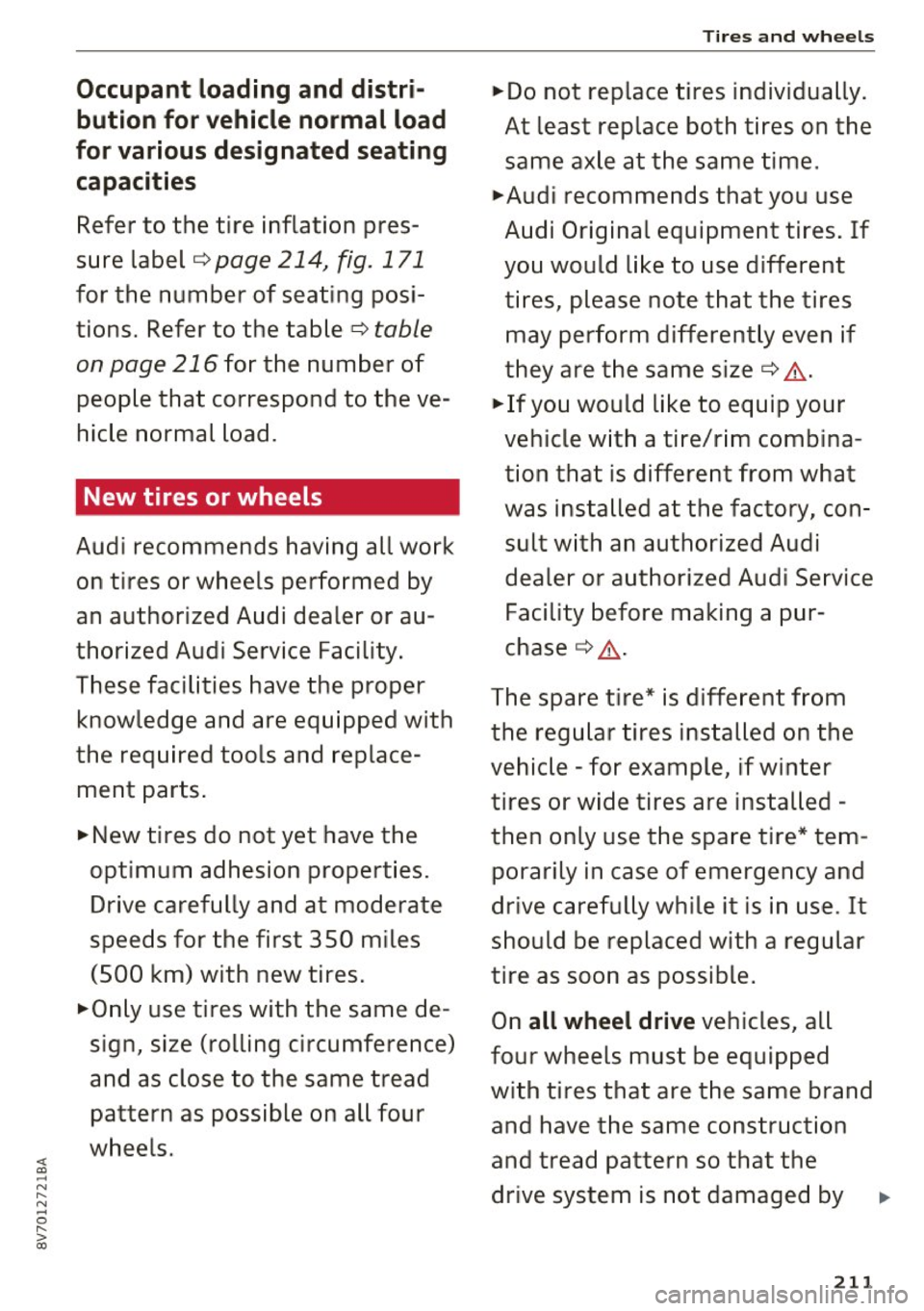
<( a:, ... N .... N ... 0
s: a:,
Occupant loading and distri
bution for vehicle normal load
for various designated seating
capacities
Refer to the tire inflation pres
sure label
c::> page 214, fig. 171
for the number of seating posi
tions. Refer to the table
c::> table
on page 216
for the number of
people that correspond to the ve
hicle normal load.
New tires or wheels
Audi recommends having all work
on tires or whee ls perfo rmed by
an authorized Audi dealer or au
thorized Audi Service Facility .
These facilities have the proper
knowledge and are equ ipped with
the required tools and replace
ment parts .
.,,. New tires do not yet have the
opt imum adhesion properties.
Drive carefully and at moderate
speeds for the first 350 m iles
(500 km) with new tires .
.,,. On ly use tires w ith the same de
sign, size (rolling c ircumference)
and as close to the same tread pattern as possible on all four
wheels.
Tire s and wheel s
.,,.Do not replace tires individually.
At least replace both tires on the same axle at the same time .
.,,. Audi recommends that you use
A udi Original equipment tires. If
you would like to use different
tires, please note that the tires may perform differently even if
they are the same si ze
c::> ,&. .
.,,. If you would like to equip your
vehicle w ith a tire/r im comb ina
tion that is different from what
was installed at the factory, con
sult w ith an authorized Audi
dealer or authorized Audi Service
Facility before making a pur
chase ¢
..1,..
The spare t ire* is diffe rent from
the regular tires installed on the
vehicle - for example, if winter
tires or wide tires are installed -
then only use the spare tire* tem
porarily in case of emergency and
drive carefully while it is in use . It
should be replaced with a regular
tire as soon as possible.
On
all wheel d rive vehicles, all
four wheels must be equipped
with tires that are the same brand
and have the same construction
and tread pa ttern so that the
drive system is not damaged by
2 11
Page 212 of 272
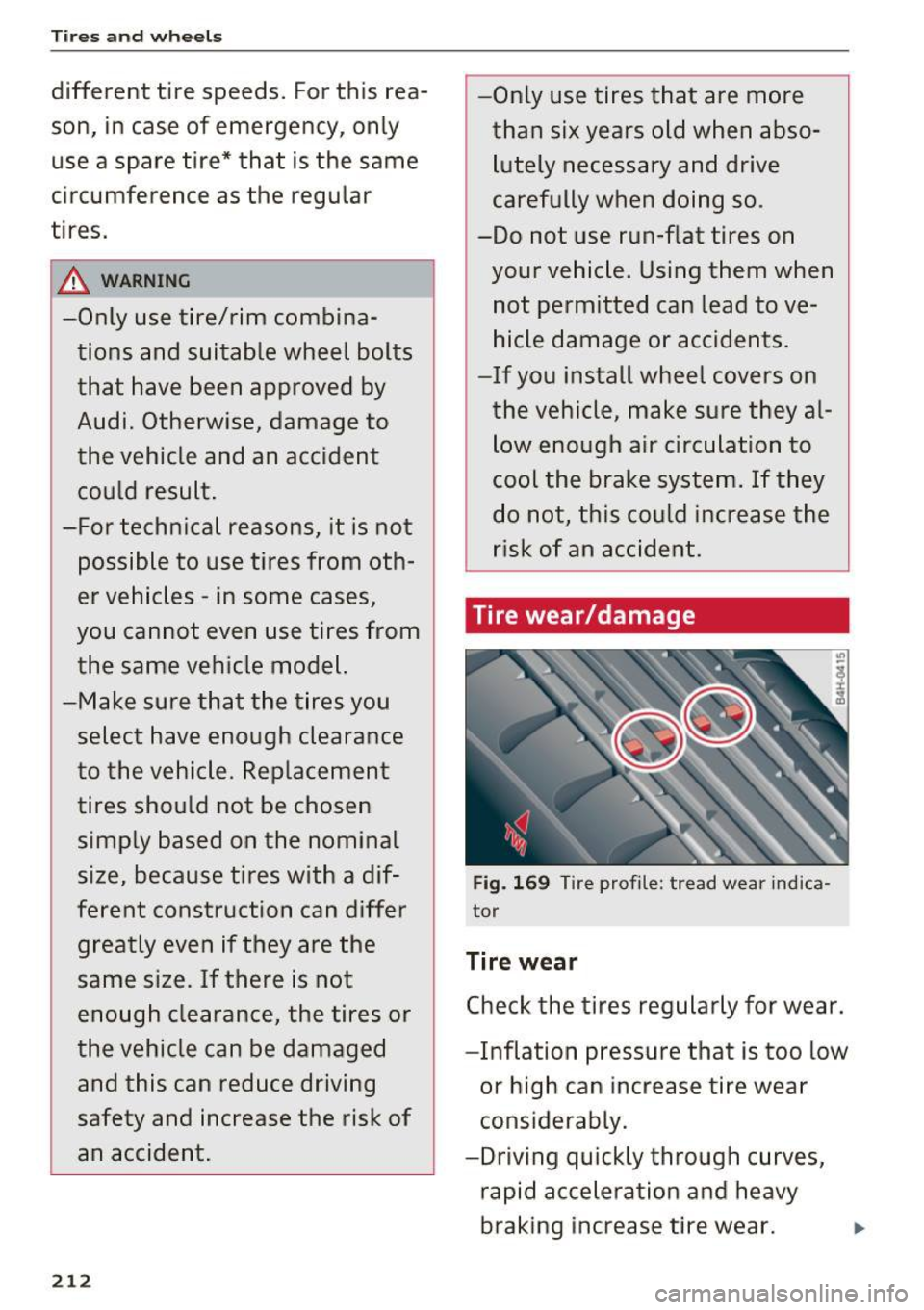
Tires and wheels
different tire speeds. For this rea
son, in case of emergency, only
use a spare tire* that is the same
circumference as the regular
tires.
,&. WARNING -
-Only use tire/rim combina
tions and suitable wheel bolts
that have been approved by
Audi. Otherwise, damage to
the vehicle and an accident could result.
-For technical reasons, it is not possible to use tires from oth
er vehicles - in some cases,
you cannot even use tires from
the same vehicle model.
-Make sure that the tires you select have enough clearance
to the vehicle. Replacement
tires should not be chosen simply based on the nominal
size, because tires with a dif
ferent construction can differ
greatly
even if they are the
same size. If there is not
enough clearance, the tires or
the vehicle can be damaged and this can reduce driving
safety and increase the risk of an accident.
212
-Only use tires that are more
than six years old when abso lutely necessary and drive
carefully when doing so.
-Do not use run-flat tires on your vehicle. Using them when not permitted can Lead to ve
hicle damage or accidents.
-If you install wheel covers on
the vehicle, make sure they al
low enough air circulation to
cool the brake system. If they
do not, this could increase the
risk of an accident.
Tire wear/damage
Fig. 169 Tire profile: tread wear indica
tor
Tire wear
Check the tires regularly for wear.
-Inflation pressure that is too low
or high can increase tire wear
considerably.
-Driving quickly through curves, rapid acceleration and heavy
braking increase tire wear. ..
Page 213 of 272
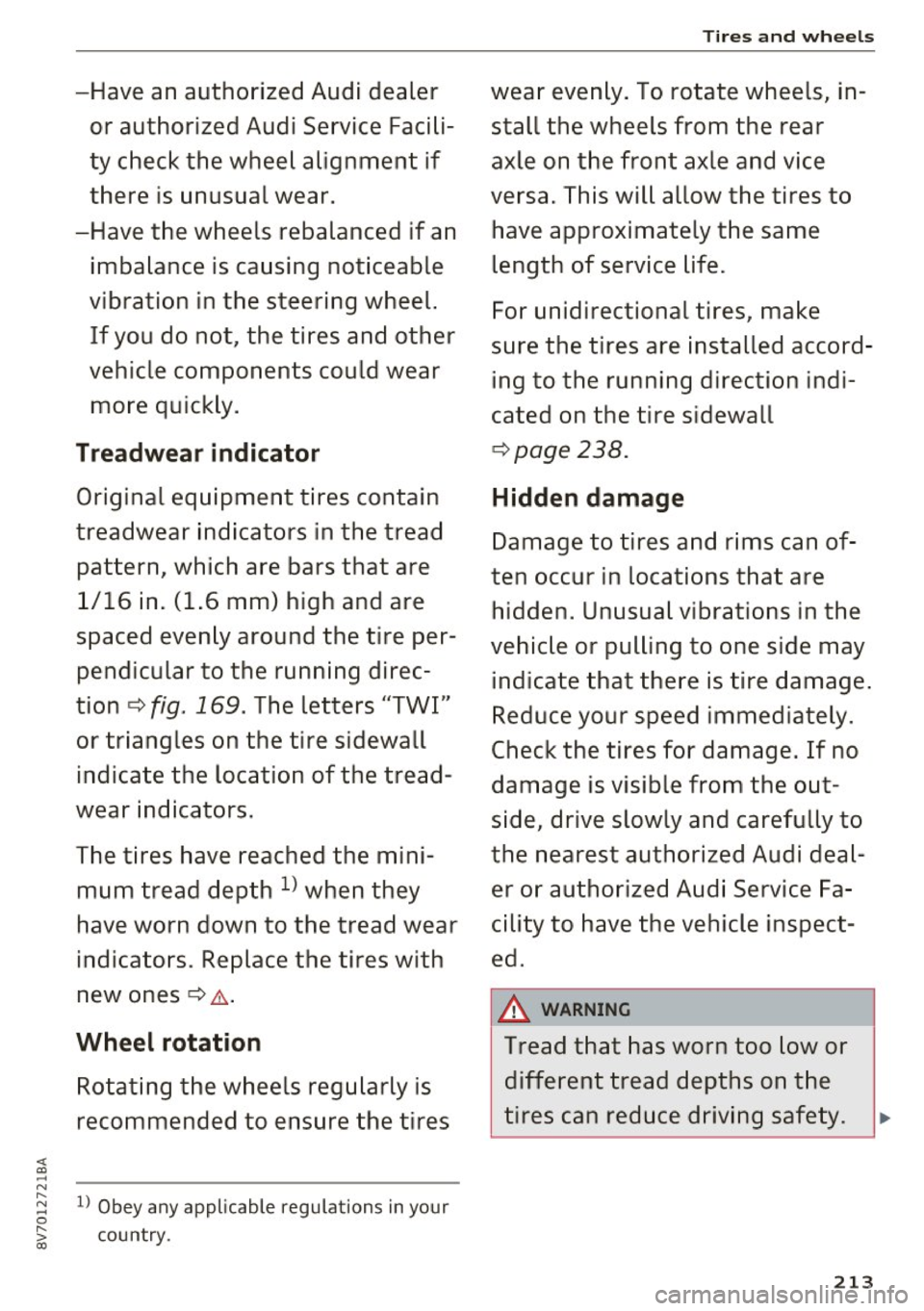
Tires and wheels
-Have an authorized Audi dealer wear evenly. To rotate wheels, in-
or authorized Audi Service Facili- stall the wheels from the rear
ty check the wheel alignment if axle on the front axle and vice
there is unusual wear. versa. This will allow the tires to
-Have the wheels rebalanced if an have approximately the
same
imbalance is causing noticeable length of service life.
vibration in the steering wheel.
For unidirectional tires, make
If you do not, the tires and other sure the tires are installed accord-
vehicle components could wear ing to the running direction indi-
more quickly. cated on the tire sidewall
Treadwear indicator ¢page 238.
Original equipment tires contain Hidden damage
treadwear indicators in the tread
Damage to tires and rims can of-
pattern, which are bars that are ten occur in locations that are
1/16 in. (1.6 mm) high and are
hidden. Unusual vibrations in the
spaced evenly around the tire per- vehicle or pulling to one side may
pendicular to the running di rec- indicate that there is tire damage.
tion
¢fig. 169. The letters "TWI"
Reduce your speed immediately.
or triangles on the tire sidewall Check the tires for damage. If no
indicate the location of the tread- damage is visible from the out-
wear indicators. side, drive slowly and carefully to
The tires have reached the mini- the nearest authorized Audi deal-
mum tread depth
l) when they er or authorized Audi Service Fa-
have worn down to the tread wear cility to have the vehicle inspect-
indicators . Replace the tires with ed.
new ones¢ &.
& WARNING
-
Wheel rotation Tread that has worn too low or
Rotating the wheels regularly is different tread depths on the
recommended to ensure the tires tires can reduce driving safety.
..
<( a:, ... N .... l) Obey
any applicable regulations in your N ... 0 .... country. > a:,
213
Page 214 of 272

Tires and wheels
This can especially have a nega
t ive effect on handling, on the
risk aquaplaning when driving
through water, when driving
through curves and when brak ing, which increases the risk of
an accident.
Tire pressure
Fig. 170 Dr iver's side 8-pillar: tire pres
sur e lab el
-"' -r,...-------------~
•c==. ~:t I :'.!: I :,. 1)§ l il! ................. .._.. ....................... .... . .. , '--................................ ,............ .... -.
TN 11D COt..O TN Nl&AUM. ,_U ~ ,,,...,..00,....AMOID
- KP aPSt
- KPA. a PSI
- KPA. a PSl
Fig. 171 Tire pressure label
SIE OWNl:llt'S MAN UAL FOR AD0010NAl 1NfOAMAT101-4 ~l[M.ANUCL DU PMCM"M T Al!IJ[ POW. ,tU$ Dl MNSC.JONlMtNTS
The correct tire pressure for tires
mounted in the factory and for
the spare tire* is indicated on a la
bel. The label is located on the B
pillar
¢fig. 170, ¢fig. 171.
When the vehicle is partially load
ed (up to 3 people), use the tire
214
pressure specified for normal
loads¢
table on page 216. If
driving the vehicle when fully loaded, you must increase the tire
pressure to the maximum speci
fied pressure ¢.&, .
Checking/correcting tire
pressure
.,.Check the tire pressure at least
once per month and also check it
before every long drive .
.,.Always check the tire pressure
when the tires are
cold . Do not
reduce the pressure if it increas
es when the tires are warm .
.,.Check the label ¢
fig. 171 for
the correct tire pressure based
on vehicle load.
.,.Correct the tire pressure if nec
essary .
.,.Vehicles with Tire Pressure Mon
itoring System*: store the modi
fied tire pressure in the Infotain
ment system ¢
page 223.
.,.Check the pressure in the emer
gency tire* /spare tire*. Always
maintain the maximum temper
ature that is specified for the
tire. .,.
Page 215 of 272

<( a:, ... N .... N ... 0
s: a:,
A WARNING
Always adapt the tire pressure
to your driving style and vehicle load.
-Overloading can lead to loss of
vehicle control and increase the risk of an accident. Read
and follow the important safe
ty precautions in¢
page 216,
Tires and vehicle load limits.
-The tire must flex more if the
tire pressure is too low or if
the vehicle speed or load are
too high. This heats the tire up
too much. This increases the risk of an accident because it
can cause the tire to burst and result in loss of vehicle con
trol.
-Incorrect tire pressure in creases tire wear and has a
Tire pressure table
Please note that the information
contained in the following table
was correct at the time of print
ing, and the information is sub
ject to change. If there are differ
ences between this information
and the tire pressures specified
on the label on the driver's side B pillar, always follow the specifica-
Tires and wheels
negative effect on driving and
braking behavior, which in
creases the risk of an accident.
Replace lost valve caps to re
duce the risk of damage to the
tire valves.
@ For the sake of the environment
Tire pressure that is too low in
creases fuel consumption.
(1) Tips
Audi recommends using the
tire pressure specified for a normal load ¢
table on
page 216
or for a full load
when the vehicle is partially
loaded.
tion on the B-pillar label
¢ page 214, fig. 170.
Make sure that the tire designa
tion on your tire matches the des ignation on the tire pressure label
and the tire pressure table.
The following table lists recom mended tire pressures in cold
215
Page 216 of 272
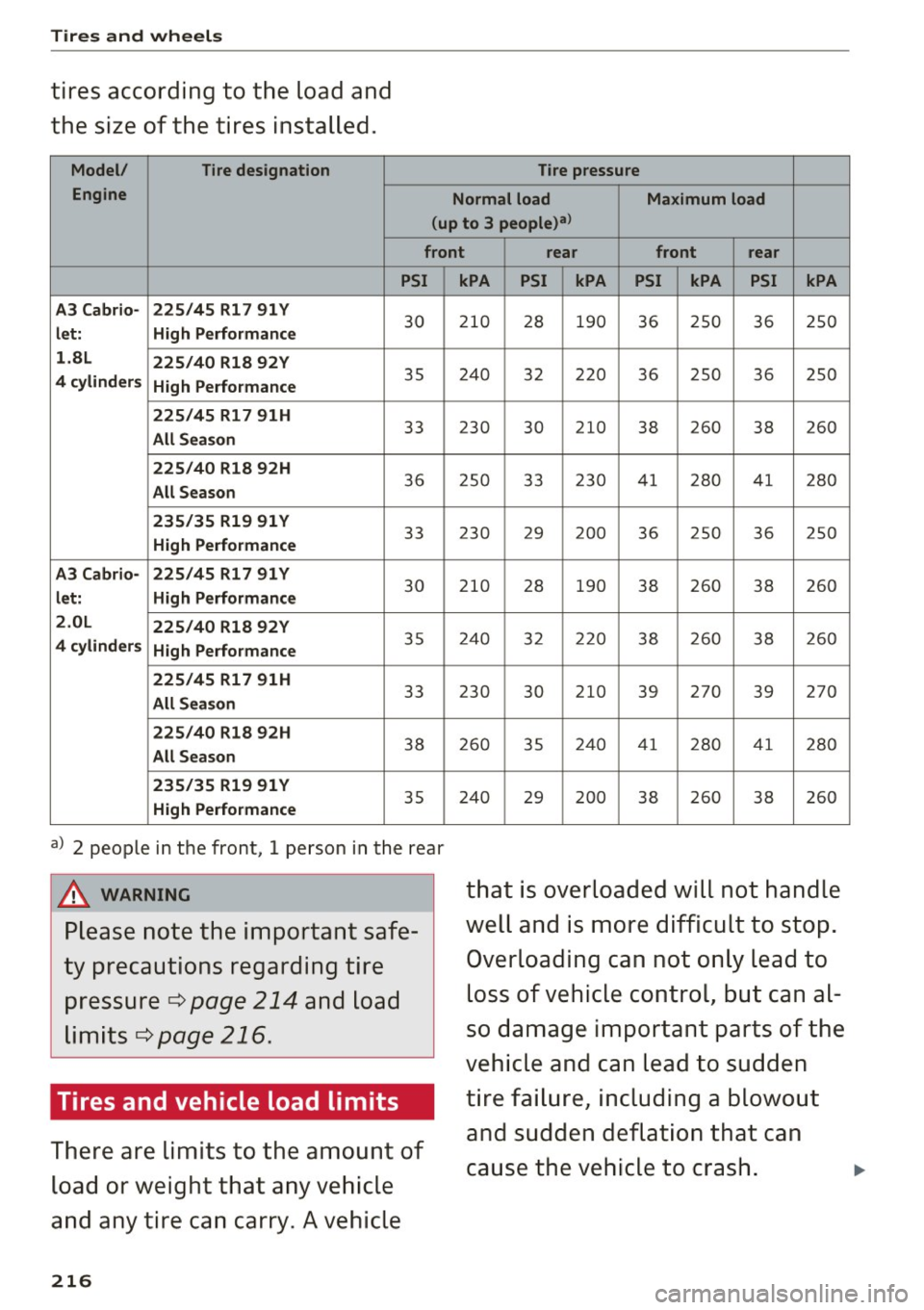
Tires and wheels
tires according to the load and
the size of the tires installed.
Model/ Tire designation
Engine Tire pressure
Normal load Maximum load
(up to 3 people)
3>
front rear front rear
PSI
A3 Cabrio- 225/45 Rl7 91Y let: High Performance
30
l.8L
225/40 Rl8 92Y
4 cylinders High Performance
35
225/45 Rl 7 91H
All Season
33
225/40 Rl8 92H
All Season
36
235/35 Rl9 91 Y
High Performance
33
A3 Cabrio- 225/45 Rl 7 91 Y
let: High Performance
30
2.0L 225/40 Rl8 92Y
4 cylinders High Performance
35
225/45 Rl 7 91H
All Season
33
225/40 Rl8 92H
All Season
38
235/35 Rl9 91 Y
High Performance
35
a) 2 people in the front , 1 perso n in the rear
.&, WARNING
Please note the important safe
ty precautions regarding tire
pressure
¢ page 214 and load
limits
¢page 216.
Tires and vehicle load limits
There are limits to the amount of
load or weight that any vehicle
and any tire can carry. A vehicle
216
kPA PSI kPA PSI kPA PSI kPA
210 28 190 36 250 36 250
240 3 2 220 36 2 50 36 250
2 30 30 210 38 260 38 260
250 33 230 41 280 41 280
2 30 29 200
36 25
0
36 25
0
210 28 190 38 260 38 260
240 32 220 38 260 38 260
230 30 2 10 39 270
39 270
260 35 240 41 280 41 280
240 29 200 38 260
38 260
that is
overloaded will not handle
well and is more difficult to stop.
Overloading can not only lead to
loss of vehicle control, but can al
so damage important parts of the
vehicle and can lead to sudden
tire failure, including a blowout
and sudden deflation that can
cause the vehicle to crash.
Page 217 of 272
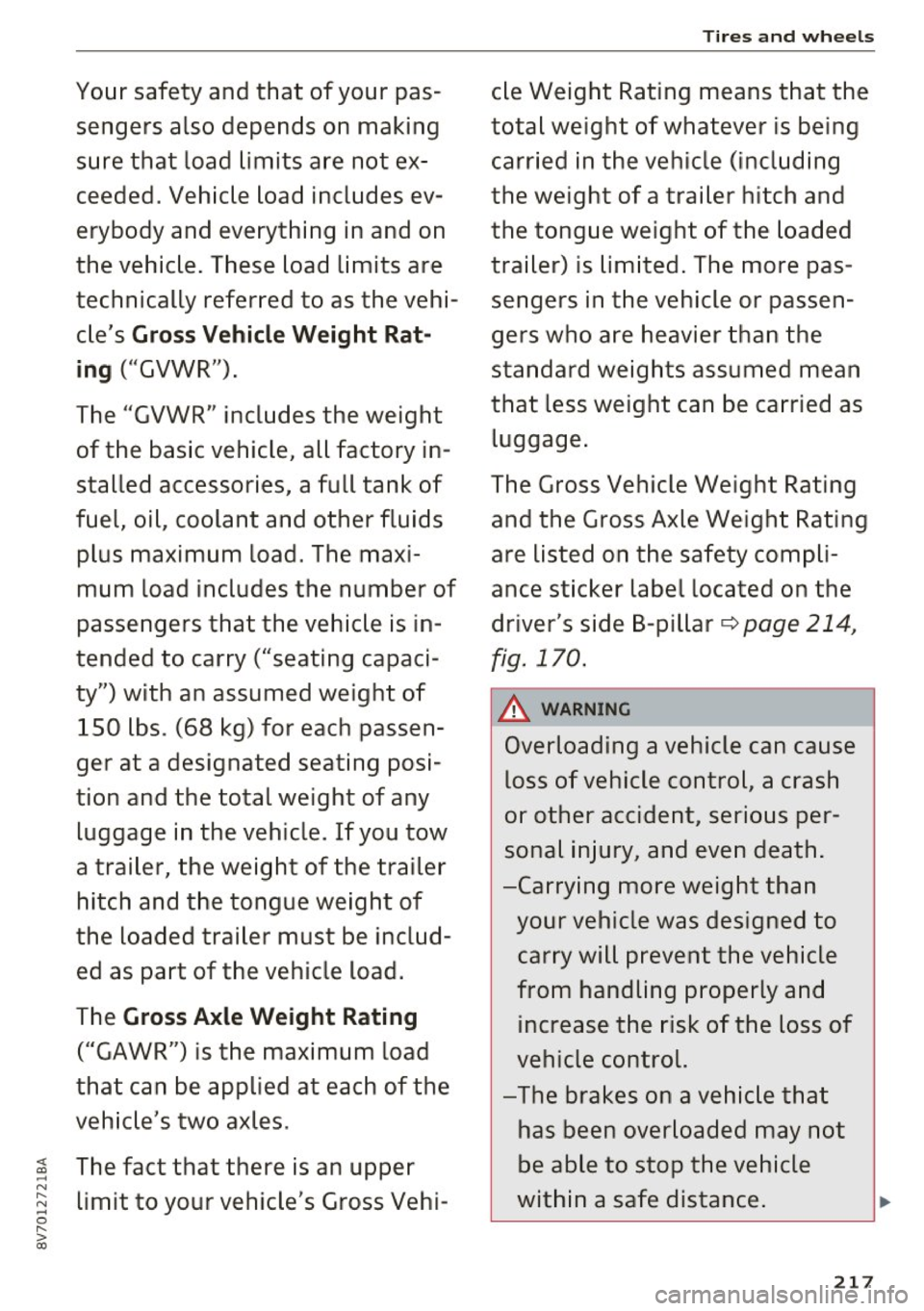
Your safety and that of your passengers also depends on making
sure that load limits are not ex
ceeded. Vehicle load includes ev
erybody and everything in and on
the vehicle. These load limits are
technically referred to as the vehi
cle's
Gross Vehicle Weight Rat
ing
("GVWR").
The "GVWR" includes the weight
of the basic vehicle, all factory in
stalled accessories, a full tank of
fuel, oil, coolant and other fluids
plus maximum load. The maxi
mum load includes the number of
passengers that the vehicle is in
tended to carry ("seating capaci
ty") with an assumed weight of
150 lbs. (68 kg) for each passen
ger at a designated seating posi
tion and the total weight of any luggage in the vehicle. If you tow
a trailer, the weight of the trailer
hitch and the tongue weight of
the loaded trailer must be includ
ed as part of the vehicle load.
The
Gross Axle Weight Rating
("GAWR") is the maximum load
that can be applied at each of the
vehicle's two axles .
; The fact that there is an upper
N
~ limit to your vehicle's Gross Vehi-
o
s: a:,
Tires and wheels
cle Weight Rating means that the
total weight of whatever is being
carried in the vehicle (including
the weight of a trailer hitch and
the tongue weight of the loaded
trailer) is limited. The more pas
sengers in the vehicle or passen
gers who are heavier than the
standard weights assumed mean
that less weight can be carried as
luggage.
The Gross Vehicle Weight Rating
and the Gross Axle Weight Rating
are listed on the safety compli
ance sticker label located on the driver's side B-pillar
9page 214,
fig. 170.
A WARNING
Overloading a vehicle can cause
loss of vehicle control, a crash
or other accident, serious per
sonal injury, and even death.
-Carrying more weight than your vehicle was designed to carry will prevent the vehicle
from handling properly and increase the risk of the loss of
vehicle control.
-The brakes on a vehicle that
has been overloaded may not
be able to stop the vehicle
within a safe distance.
217
Page 218 of 272
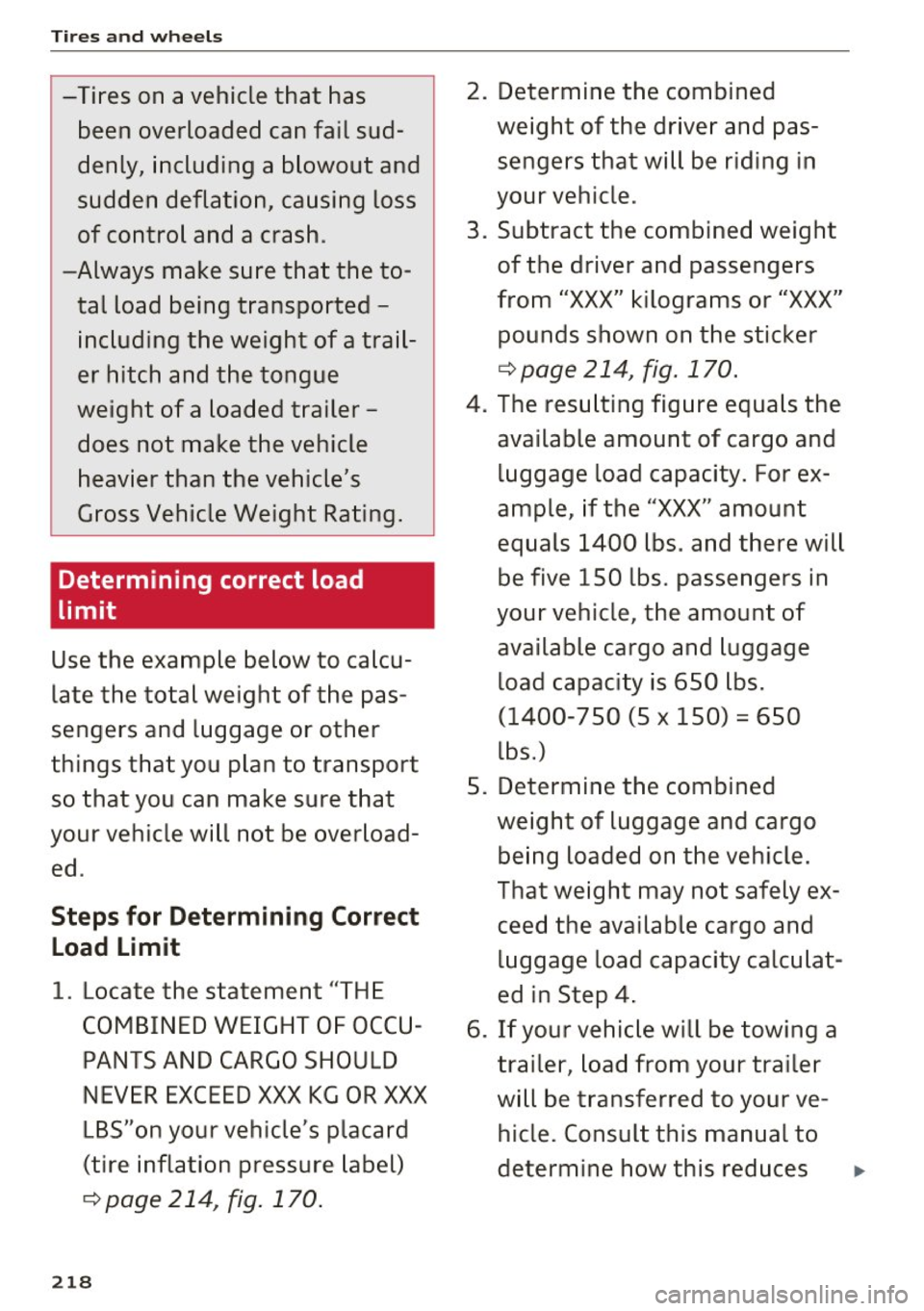
Tires and wheels
-Tires on a vehicle that has been overloaded can fail sud
denly, including a blowout and
sudden deflation, causing loss of control and a crash .
-Always make sure that the to tal load being transported -
including the weight of a trail
er hitch and the tongue
weight of a loaded trailer does not make the vehicle
heavier than the vehicle's
Gross Vehicle Weight Rating.
Determining correct load
limit
Use the example below to calcu
late the total weight of the pas
sengers and luggage or other
things that you plan to transport
so that you can make sure that
your vehicle will not be overload ed .
Steps for Determining Correct
Load Limit
1 . Locate the statement "THE
COMBINED WEIGHT OF OCCU
PANTS AND CARGO SHOULD
NEVER EXCEED XXX KG OR XXX
LBS"on your vehicle's placard
(tire inflation pressure label)
¢page 214, fig.170.
218
2. Determine the combined
weight of the driver and passengers that will be riding in
your vehicle.
3. Subtract the combined weight
of the driver and passengers
from
"XXX" kilograms or "XXX"
pounds shown on the sticker
¢page 214, fig. 170.
4. The resulting figure equals the
available amount of cargo and
luggage load capacity. For ex
ample, if the "XXX" amount
equals
1400 lbs . and there will
be five
150 lbs. passengers in
your vehicle, the amount of
available cargo and luggage
load capacity is 650 lbs.
(1400-750 (5 X 150) = 650
lbs.)
5. Determine the combined
weight of luggage and cargo being loaded on the vehicle.
That weight may not safely ex ceed the available cargo and luggage load capacity calculat
ed in Step 4.
6. If your vehicle will be towing a trailer, load from your trailer
will be transferred to your ve
hicle. Consult this manual to
determine how this reduces ...
Page 219 of 272

<( co .... N r--N .... 0 r--> co
the availab le cargo an d lug
gage loa d capaci ty o f yo ur vehi
c le.
.,,. Chec k the tire s idewall
(¢ page 204 , fig. 16 8) to deter
min e th e des ig nate d lo ad ratin g
for a speci fic tir e.
Wheel bolts and rims
Wheel b olts
Wheel bolts must be clean and loosen/t ighten
eas ily.
Rims
R ims with a bolted rim ring* or w ith bolted wheel
covers* consist of mu ltip le pieces . These compo
n ents we re bolted toge ther using specia l bolts
and a specia l procedure . You must not repair or
disassemble them¢
A.
A WARNING
-
Wheel bolts that are tightened or repaired in
correctly can become loose and result in loss
of vehicle control, which increases the risk of
an acc ident. For the correct tightening specif i
cation, refer to¢
page 235, After changing a
wheel .
-Always keep the wheel bolts and the
threads in the wheel hub clean and free of
grease.
- Only use wheel bolts that fit the rim.
-Always have damaged r ims repaired by an
authorized Audi dealer or authorized Aud i
Service Facility. Never repair or d isassemble
rims yourself, because this increases the risk
of an accident.
Winter tires
W inter tires s ignificantly improve the vehicle's
h andling w hen d riving in w inter condit ions. Be
cause of the ir constr uction (width, compound,
tread pattern), summe r tires provide less trac
tion on ice and snow.
Tir es and wheel s
.. Use winter tires on all four wheels.
.. On ly use winter tires that are approved for your
veh icle.
.. Please note that the maximum permitted
speed may be lower with winter tires¢,&. An
author ized Audi dealer or authorized Audi Serv
ice Facility can inform you about the maximum
perm itted speed for your t ires .
.. Check the tire p ressure afte r insta lling wheels
¢ page 214.
The effectiveness of winter tires is reduced great
ly when the tread is wo rn down to a depth of
0.157 i nch (4 mm). The characte ris tics of winter
t ir es also decrease g reatly as the ti re ages, re
gard less of the rema ining t read.
A WARNING
-- Never drive faster than the max imum per
mitted speed for your tires . This could cause
the t ires to heat up too much. This increases
the risk of an accident because it can cause
the t ire to burst.
- Always adapt your driving to the road and
traffic cond itions. Drive carefully and reduce
your speed on icy or slippery roads . Even
winter t ires can lose tract ion on black ice .
(® For the sake of the environment
Reinstall summer tires at the appropr iate
time, because they prov ide better handling
when roads are free of snow and ice. Summer
tires cause less road no ise, tire wear and fue l
consumpt ion.
(D Tips
You can also use all season tires instead of
winter tires. Please note that in some coun
tries where winter tires are required, on ly
winter tires w ith the
& symbo l may be per
mitted.
Snow chains
Snow chains improve traction in the snow.
.. Only install snow chains on the front wheels .
This applies a lso to vehicles with a ll wheel
drive*.
219
Page 220 of 272

Tires and wheels
"' Check and cor rect the seating of the snow
c h ains if necessa ry after dr iving a few feet. Fo l
l ow the instructions from the manufacturer .
"' Note the maximum permitted speed when d riv
i ng with snow chains. Do not exceed 30 mp h
(SO km/h) .
Snow chains not only improve the
driving in win
ter road conditions, but also the
broking .
Use of snow cha ins is o nly pe rmitted with certain
rim/t ire combinations due to tec hnical reasons .
C hec k with an authorized A udi dealer o r autho r
i z ed Audi Service Fac ility to see if yo u may use
snow cha ins.
Use
fine-mesh snow chains . They must not add
mo re t han 0.53 inch (13.5 mm) in height, includ
i n g the chain loc k.
You must remove the c hains when d riving on
roads that are
free of snow . W hen roads a re free
of snow, snow c hains ca n impair handling and
damage the ti res, and the chai ns w ill quickly be
destroyed.
A WARNINC
Us ing inco rrect snow c hains or insta lling snow
c hai ns inco rre ctl y can resul t in loss o f vehicle
c o ntro l, w hich incr ease s th e ris k of an a cci
d ent .
(D Note
Snow chains can damage th e rims/wheel cov
ers* i f the cha ins come in to d irect contact
w it h t hem. R emove the w heel c overs* first .
U se coat ed sn ow cha ins.
Low aspect ratio tires
Your Au di is fac to ry-equipped wi th low aspec t ra
tio tires . These ti res have been tho roughly tested
a nd been se lected specifically fo r yo ur model fo r
their supe rb per fo rmance, road feel and handling
un der a variety of driving conditions . As k yo ur au
thor ized Audi dealer for mo re details.
The low aspect ratio of these t ires is i ndicated by
a numeral of
55 or less in t he tire's size designa
tion. The nume ra l rep resents the rat io of the
tire's sidewall he ight i n relat io n to its tread width
220
exp ressed in perce nta ge . Conventiona l tir es h ave
a height/width ratio of 60 or more.
The performance of low-aspect -ratio tires is par
ticularly sensitive to improper inflation pres
sure. It is therefore important that low aspect ratio tires are inflated to the specified pressure
and that the inflation pressure is regularly
checked and maintained. Tire pressures should
be checked at least once a month and always
before a long trip
r=> pog e 214.
What you can do to avoid tire and rim
damage
Low aspect ratio tires can be damaged more eas i
l y by impact with potho les, curbs, gullies or
r idges on the road, particularly if the tire is un
der inflated .
In orde r to min imize the occur rence of impact
damage to the tires of you r vehicle, we recom
mend that you observe the following preca u
tions:
- Always ma intain recommended inflation pres
sures. Check you r tir e pressure every
2,000 miles (3,000 km) and add a ir if necessa
ry.
- Dr ive ca refully on roads w it h potholes, deep
gu llies o r ridges . Th e impac t from dr iv ing
t hroug h or over such o bstacl es ca n da mage
your tire s. I mpac t w ith a curb may also cau se
d am age to yo ur ti re s.
- After any impac t, imme diate ly inspect you r
t ire s or h ave them inspe cted by t he nea rest a u
t hori ze d Audi d ealer. Repl ace a dama ged t ire as
soon as possible.
- Ins pect your tir es eve ry 2,00 0 m iles (3,0 00 k m)
for dama ge and wear. Dam age is no t always
easy to see . Damage can lead to loss of a ir and
unde rinflation, w hich coul d event ua lly cause
tire fa ilure. If yo u be lieve that a tire may have
been damaged, replace the tire as soon as pos
sible .
- These tires may wear mo re quick ly than others.
- Please also remember that, while t hese tires
delive r responsive hand ling, they may ride less
comfortably and make mo re noise than other
choices. ""